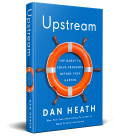In the book, we tell a story about a group called “Beyond War,” which tried to mobilize public opinion against the nuclear arms race. As part of their anti-nukes presentations, they’d do a demonstration that involved dropping BBs in a bucket. (See full passage below for context.) Now you can hear what it sounds like for yourself. (Thanks to Dan O’Day for the clip.)
Excerpt:
The use of vivid details is one way to create internal credibility–to weave sources of credibility into the idea itself. Another way is to use statistics. Since grade school, we’ve been taught to support our arguments with statistical evidence. But statistics tend to be eye-glazing. How can we use them while still managing to engage the audience?
Geoff Ainscow and other leaders of the “Beyond War” movement in the 1980s, were determined to find a way to address the following paradox: When we see a child running with scissors, we wince. We shout at them to stop. Yet when we read in the newspaper about nuclear weapons—with the power to destroy millions of children—it only provokes, at best, a moment of dismay.
“Beyond War” was started by a group of citizens who were alarmed by the arms race of the U.S. and the Soviet Union. By then, the combined Soviet and American nuclear arsenals were sufficient to destroy the world multiple times. The “Beyond War” participants went door-to-door in their neighborhoods, hoping to galvanize a public outcry against the arms race.
They struggled with how to make credible their belief that the arms race was out of control. How do you make clear to people the staggering destructive capability of the world’s nuclear stockpile? It’s so intangible, so invisible. And yet telling stories, or providing details, seems inadequate: To grapple with the nuclear arms race requires grappling with the scale of it. Scale relies on numbers.
“Beyond War” would arrange “house parties”—a host family would invite over a group of friends and neighbors and invite a Beyond War representative to speak to them. Ainscow recounts a simple demonstration that the group would use in its presentations. Ainscow would carry a metal bucket to the talk. At the appropriate point in the presentation, he’d take a BB out of his pocket and drop it in the empty bucket. The BB would make a loud clatter as it ricocheted and settled. He’d say, “This is the Hiroshima bomb.” He would spend a few minutes describing the devastation of the Hiroshima bomb, the miles of flattened buildings, the tens of thousands killed immediately, the larger number of people with burns or other longer term health problems.
Next, he’d drop 10 BBs into the bucket. The clatter was louder and more chaotic. “This is the firepower of the missiles on one U.S. or Soviet nuclear submarine.”
Finally, he’d ask the attendees to close their eyes. He’d say, “This is the world’s current arsenal of nuclear weapons.” Then, Ainscow would pour 5,000 BBs into the bucket (one for every nuclear warhead in the world). The noise was startling, even terrifying. He says, “The roar of the BBs went on and on. Afterward there was always dead silence.”
This approach is an ingenious way to convey a statistic. Let’s unpack it a bit. First, ”Beyond War” had a core belief: “The public needs to wake up and do something about the arms race.” Second, they determined what was unexpected about the message: Everyone knew that the world’s nuclear arsenal had grown since World War II, but no one realized the scale of the growth. Third, they had a statistic to make their belief credible—i.e., that the world had 5,000 nuclear warheads, when a single one was enough to decimate a city. But the problem was that the number 5,000 means very little to people. The trick was to make this large number meaningful.
The final twist was the demonstration—the bucket and the BBs which added a sensory dimension to an otherwise abstract concept. Furthermore, the demonstration was carefully chosen—BBs are weapons, and the sound of the BBs hitting the bucket was fittingly threatening.
Notice something that may be counter-intuitive: The statistic didn’t stick. It couldn’t possibly stick. No one who saw the demonstration would remember, a week later, that there were 5,000 nuclear warheads in the world.
What did stick was the sudden, visceral awareness of a huge danger—the massive scale-up from World War II’s limited atomic weaponry to the present worldwide arsenal. It was irrelevant whether there were 4,135 nuclear warheads or 9,437. The point was to hit people in the gut with the realization that this was a problem that was out of control.
This is the most important thing to remember about using statistics effectively. Rarely will statistics be meaningful in and of themselves. Statistics will, and should, almost always be used to illustrate a relationship. It’s more important for people to remember the relationship than to remember the statistic.



